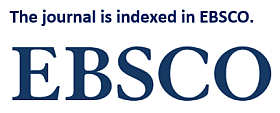Mineralogical characteristic of rutile from Bonče, Republic of Macedonia
Abstract
This paper gives mineralogical characteristic of rutile. Several samplesof rutile were collected for research by Scanning electron microscopy (SEM),coupled with an energy dispersive X-ray spectrometer (EDS) and X-raydiffraction (XRD). SEM is especially useful because it gives elemental,mineralogical and morphological data at the same time. X-ray diffraction(XRD) is known as the best method for the identification and quantification ofminerals The instrument used was a XRD Schimadzu 6100. Copper radiationwas used CuKα= 1.54178̊A, the voltage of the generator 40 kV, and thecurrent was 30 mA. 2θ= 2◦/min. The most intense registered maxima in thestudied powder diagram were compared with the corresponding maxima inthe diagram of rutile sample JCPDS card 00 003 112 and 00 021 1276. Thecomparison has shown that the X-ray powder pattern of the natural rutile takenfrom the JCPDS card are practically identical with the studied diagram. Theresults of the X-ray powder pattern and SEM analysis enable straightforwardidentification of the studied mineral sample as rutile.Downloads
Download data is not yet available.
Downloads
Published
2014-12-31
Issue
Section
Article
How to Cite
Mineralogical characteristic of rutile from Bonče, Republic of Macedonia. (2014). Natural Resources and Technology, 8(8). https://js.ugd.edu.mk/index.php/NRT/article/view/929
.png)

